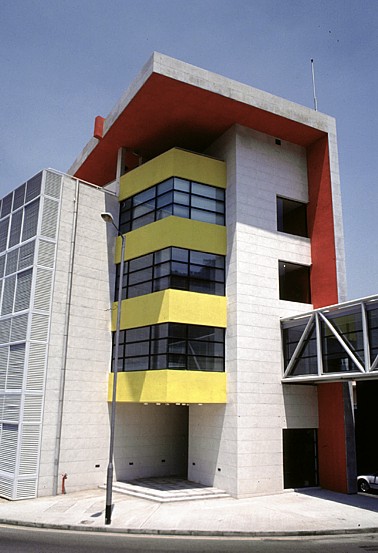|
 NEW
BUILDING OF THE DOM JOSÉ DA COSTA NUNES NURSERY SCHOOL NEW
BUILDING OF THE DOM JOSÉ DA COSTA NUNES NURSERY SCHOOL
1995-1997
DIDACTIC
ARCHITECTURE
The
new building of the Dom José da Costa Nursery School stands at the exit
to a tunnel, on the edge of one of the most complex crossroads on the
east-west axis of the city, and is traversed by a widely-used bypass.
Rather than being a hindrance, this created a challenge to the architect,
Mário Duque, who, in the written introduction to the project, speaks of
the "didactic role" that architecture can and should play...
The
main factor determining the solutions found for this project was the
disturbing presence of the adjacent bypass. Thus, all the new buildings to
the south of this axis orientate the activity in the direction of the Rua
da Fonte da Inveja, which has a more moderate circulation and is more
favourably oriented in relation to the sun.
The space under the bypass, between the existing building and the new
constructions, and corresponding to the old recreation area of the Nursery
School, will be treated exclusively as a visual and environmental framing,
which will serve not only the urban context but also the interior of the
building, namely, the glazed corridor joining the two parts of the school.
In other words it won’t be used as an external place of recreation, for
obvious security reasons[...]
The adaptability of a functional programme to the activities undertaken in
a nursery school cannot be thought through without careful consideration
being given to the fact that it is at nursery school that the child might
enjoy its first great spatial and motor experiences... The role of
architecture could therefore be active to the point of being didactic,
furnishing the necessary signs for the establishment of a spatial lexicon
which the child learns directly from his or her lived experience. The aim
would therefore be to render the space more appealing and adventurous for
such a learning process
The structural space should therefore be supportive to children in their
social and sensorial learning processes, with the aim of awakening a
spatial awareness in the same playful manner as other abilities or
aptitudes are awakened.
The apprehension of spatial relations stems from this learning process,
with regard to the principle spatial orientations, dimensions and
variables: tall/short, long/short, flat/curved, straight/inclined,
continuous/broken, light/dark, hot/cold, full/empty, interior/exterior,
old/new, object, form and colour all these are variables in a spatial
vocabulary.
These were the thoughts and considerations of the architect for the
new Nursery School and all of these relate to my own happy memories of the
João de Deus Nursery School in Lisbon. There was a bust representing João
de Deus already in existence here in the Nursery School of Dom José da
Costa Nunes, and this will be given a place of honour on the outside of
the building.
— There is an obvious preoccupation with protecting the building from
surrounding urban "accidents", and this will eventually
determine the final project. Are the children, once indoors, in fact
protected from the different types of pollution that affect this area?
With regard to the urban space, the building is indeed a kind of
shell, but at the same time, there is no lack of either light or views
onto the outside. The polluting effects of the surrounding environment
were analyzed, permitting Architecture to solve the equation! In this way,
the spaces which are put to greater use are situated in areas where the
noise is reduced and where the light is brighter, and these spaces are
therefore obviously protected against the noisier, more polluted areas.
The windows are shaded or even darkened where the light is too strong, and
these windows animate the large white facade in a diversified fashion. The
windows are placed low given that the principle users of the building are
children and are equipped with devices that allow them to be opened and
shut by adults alone, and even then, from a central security command unit.
The large window is a small segment of a corridor animated once in a while
by people walking past, already in the administrative spaces of the
building: passing through these spaces, one is surprised by the glimpse of
the Colina da Guia (Guia hill) where the cars flashing by on the bypass
seem like toys.
— You must, however, surely be aware of the criticisms levelled at
the fact that some of the interiors were incomplete at the beginning of
the school year...
From all of the above, it must be obvious that the whole process of
construction of this building has been highly complex, although certainly
the final synthesis is simple: modern architecture, with its antiseptic
vocabulary, is a complex thing. I am also sure that I have not had the
opportunity to transmit this to those who use the building, I mean beyond
keeping pace with the inspection of the constructions; but it will also be
up to the users to recognize this, and to appropriate the space with
regard to the conditions offered.
With the beginning of the school year, the temporary installations of two
different institutions proved to be disturbing: they demand a kind of
flexibility that would require some adaptations which won’t be made
because we are, after all, dealing with a temporary situation. The delayed
completion of the outdoor recreation areas has made it necessary to house
the children temporarily indoors at all times, as well as necessitating
the utilisation of the All Purpose Room as a recreation centre for
break-time. Being set up for ‘All Purposes’, this room has too many
devices, so that it has to be used with some circumspection and not as a
free, recreational space.
— What were the aesthetic influences that most marked the conception
of this project?
The influences are obviously Neoplastic look for instance at the huge,
glazed window facing the bypass in an otherwise blind facade. I do not
consider this influence to be either dated or revivalist, but rather, that
it provides a structure of functional articulation that ought to exist as
an underpinning for any type of plastic vocabulary: I think that the
Neoplastic aesthetic was thus articulated because it was, essentially,
didactic.
in,
Revista
Macau Oct 97, II Nr.66
|
